Blog
Ankle Stretches
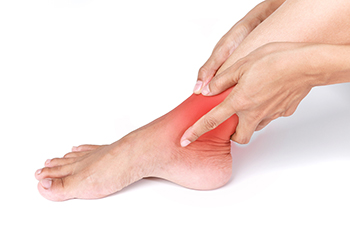
Many different individuals might experience some kind of ankle pain or stiffness at some point in their lives. There are many different causes and types of ankle pain. However, if the ankle is feeling stiff, sore, or painful, gently stretching the ankle may be beneficial for some people. An individual might consider performing ankle circles where, in a seated position with one leg crossed over another, you move the foot off of the ground in a circle. Another potential stretch is known as the towel stretch where a person sits on the ground with their legs stretched out in front of them. Then, the person wraps a towel around the bottom of the feet, and gently and repeatedly pulls the towel toward themselves. Of course, it is always a good idea to consult with a medical professional before performing stretches. Contact a podiatrist today to see if you can mitigate your ankle pain or stiffness by performing any of these stretches.
Ankle pain can be caused by a number of problems and may be potentially serious. If you have ankle pain, consult with Jack A. Sasiene, DPM from Texas. Our doctor will assess your condition and provide you with quality foot and ankle treatment.
Ankle pain is any condition that causes pain in the ankle. Due to the fact that the ankle consists of tendons, muscles, bones, and ligaments, ankle pain can come from a number of different conditions.
Causes
The most common causes of ankle pain include:
- Types of arthritis (rheumatoid, osteoarthritis, and gout)
- Ankle sprains
- Broken ankles
- Achilles tendonitis
- Achilles tendon rupture
- Stress fractures
- Bursitis
- Tarsal tunnel syndrome
- Plantar fasciitis
Symptoms
Symptoms of ankle injury vary based upon the condition. Pain may include general pain and discomfort, swelling, aching, redness, bruising, burning or stabbing sensations, and/or loss of sensation.
Diagnosis
Due to the wide variety of potential causes of ankle pain, podiatrists will utilize a number of different methods to properly diagnose ankle pain. This can include asking for personal and family medical histories and of any recent injuries. Further diagnosis may include sensation tests, a physical examination, and potentially x-rays or other imaging tests.
Treatment
Just as the range of causes varies widely, so do treatments. Some more common treatments are rest, ice packs, keeping pressure off the foot, orthotics and braces, medication for inflammation and pain, and surgery.
If you have any questions please feel free to contact our office located in Lake Jackson, TX . We offer the newest diagnostic tools and technology to treat your foot and ankle needs.
Are Bunions Affecting Your Everyday Life?
Simple Methods For Healthy Feet
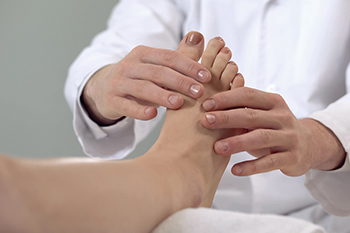
Many people throughout the world take their feet for granted. The feet are complex structures and carry the weight of the body. Foot pain can happen when the feet are neglected, and this can make completing daily activities difficult to accomplish. When the feet feel good, a patient's overall attitude may be improved. There are simple methods that can be implemented that the feet can benefit from. These consist of washing the drying the feet daily, followed by using a good moisturizer, which may be helpful in preventing cracked heels. It is imperative that shoes are comfortable and fit correctly, which may be beneficial in helping to avoid unwanted foot conditions. It is suggested that high heels be worn infrequently, and the toenails are trimmed properly. Many people check the bottoms of their feet for existing cuts, bruises, or scrapes, and this is especially important for diabetic patients to do. If you would like more information about the importance of practicing everyday foot care, please confer with a podiatrist who can offer effective tips to maintain the health of the feet.
Everyday foot care is very important to prevent infection and other foot ailments. If you need your feet checked, contact Jack A. Sasiene, DPM from Texas. Our doctor can provide the care you need to keep you pain-free and on your feet.
Everyday Foot Care
Often, people take care of their bodies, face and hair more so than they do for their feet. But the feet are a very important aspect of our bodies, and one that we should pay more attention to. Without our feet, we would not be able to perform most daily tasks.
It is best to check your feet regularly to make sure there are no new bruises or cuts that you may not have noticed before. For dry feet, moisturizer can easily be a remedy and can be applied as often as necessary to the affected areas. Wearing shoes that fit well can also help you maintain good foot health, as well as making it easier to walk and do daily activities without the stress or pain of ill-fitting shoes, high heels, or even flip flops. Wearing clean socks with closed shoes is important to ensure that sweat and bacteria do not accumulate within the shoe. Clean socks help to prevent Athlete’s foot, fungi problems, bad odors, and can absorb sweat.
If you have any questions, please feel free to contact our office located in Lake Jackson, TX . We offer the newest diagnostic and treatment technologies for all your foot care needs.
Simple Methods of Caring for Children’s Feet
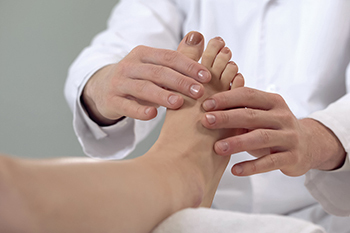
It is beneficial to pay attention to your baby's feet as they grow into childhood. It can pave the way to having healthy feet as an adult and this may be helpful in preventing unpleasant foot conditions from developing. One of the first steps in taking care of babies' feet consists of washing and drying them thoroughly, especially between the toes. Additionally, it is helpful to trim the toenails once per week and sometimes more frequently if the nails are growing quickly. Cutting the toenails in a straight line is the proper way to trim children’s toenails, and the corners should be avoided which may prevent an ingrown toenail from developing. Many babies do not wear shoes until they walk outside, and this can help the foot become stronger as the toes grip the floor. A foul odor may be indicative of a fungal infection, and it is suggested that a podiatrist be contacted. A podiatrist can treat this accordingly and offer general tips on how to care for your child’s feet.
The health of a child’s feet is vital to their overall well-being. If you have any questions regarding foot health, contact Jack A. Sasiene, DPM of Texas. Our doctor can provide the care you need to keep you pain-free and on your feet.
Tips for Keeping Children's Feet Healthy
- Make sure their shoes fit properly
- Look for any signs of in-toeing or out-toeing
- Check to see if they have Clubfoot (condition that affects your child’s foot and ankle, twisting the heel and toes inward) which is one of the most common nonmajor birth defects.
- Lightly cover your baby’s feet (Tight covers may keep your baby from moving their feet freely, and could prevent normal development)
- Allow your toddler to go shoeless (Shoes can be restricting for a young child’s foot)
- Cut toenails straight across to avoid ingrown toenails
- Keep your child’s foot clean and dry
- Cover cuts and scrapes. Wash any scratches with soap and water and cover them with a bandage until they’ve healed.
If you have any questions, please feel free to contact our office located in Lake Jackson, TX . We offer the newest diagnostic and treatment technologies for all your foot care needs.
Stretches May Help Before Walking
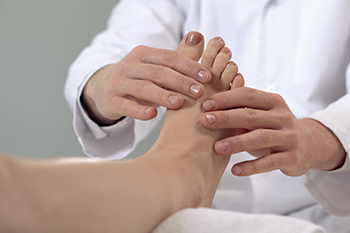
Research has shown that one of the best things you can do if you have arthritis in your feet is to walk as much as possible. This may cause pain to the feet and ankles, despite being overall beneficial. Performing stretches and exercises may strengthen the feet, possibly reduce arthritis symptoms, and this may be helpful to do before walking. An effective exercise is done by spreading marbles on the floor, followed by sitting on a chair. The marbles are picked up one at a time using the toes, and placed into a cup. Many patients find relief when their foot is placed on top of a tennis ball, and the entire foot is rolled on it. This can be beneficial in strengthening the soles of the feet. There are some patients that notice that as their feet become stronger, their arthritis symptoms may decrease. If you would like information about additional stretches to perform that can help arthritic feet, please confer with a podiatrist.
Arthritis can be a difficult condition to live with. If you are seeking treatment, contact Jack A. Sasiene, DPM from Texas. Our doctor can provide the care you need to keep you pain-free and on your feet.
Arthritic Foot Care
Arthritis is a term that is commonly used to describe joint pain. The condition itself can occur to anyone of any age, race, or gender, and there are over 100 types of it. Nevertheless, arthritis is more commonly found in women compared to men, and it is also more prevalent in those who are overweight. The causes of arthritis vary depending on which type of arthritis you have. Osteoarthritis for example, is often caused by injury, while rheumatoid arthritis is caused by a misdirected immune system.
Symptoms
- Swelling
- Pain
- Stiffness
- Decreased Range of Motion
Arthritic symptoms range in severity, and they may come and go. Some symptoms stay the same for several years but could potentially get worse with time. Severe cases of arthritis can prevent its sufferers from performing daily activities and make walking difficult.
Risk Factors
- Occupation – Occupations requiring repetitive knee movements have been linked to osteoarthritis
- Obesity – Excess weight can contribute to osteoarthritis development
- Infection – Microbial agents can infect the joints and trigger arthritis
- Joint Injuries – Damage to joints may lead to osteoarthritis
- Age – Risk increases with age
- Gender –Most types are more common in women
- Genetics – Arthritis can be hereditary
If you suspect your arthritis is affecting your feet, it is crucial that you see a podiatrist immediately. Your doctor will be able to address your specific case and help you decide which treatment method is best for you.
If you have any questions please feel free to contact our office located in Lake Jackson, TX . We offer the newest diagnostic tools and technology to treat your foot and ankle needs.
Prevention of Plantar Fasciitis
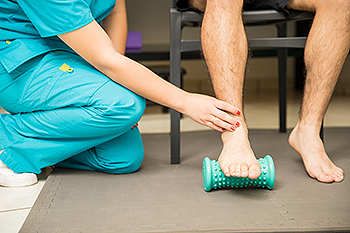
Plantar fasciitis is a condition condition involving inflammation in the ligament that extends from the toes to the heels. It is one of the most common causes of heel pain. This affliction can cause sharp pain, especially when arising in the morning, and can interfere with walking or exercise. Plantar fasciitis is caused by activities that place stress on the heel, such as running or jumping, and standing on hard surfaces for a prolonged period of time. Additionally, obesity and aging may contribute significantly to developing plantar fasciitis. Preventive measures that can be taken may include varying exercise routines to work different muscles and including low impact exercise options to reduce stress on the heel. It may be beneficial to wear a night splint on the affected foot to keep the foot and ankle in the optimal position. If you believe that you have plantar fasciitis, it is strongly suggested that you visit a podiatrist who can properly diagnose this condition and obtain treatment that may be more effective for you.
Plantar fasciitis can be very painful and inconvenient. If you are experiencing heel pain or symptoms of plantar fasciitis, contact Jack A. Sasiene, DPM from Texas. Our doctor can provide the care you need to keep you pain-free and on your feet.
What Is Plantar Fasciitis?
Plantar fasciitis is the inflammation of the thick band of tissue that runs along the bottom of your foot, known as the plantar fascia, and causes mild to severe heel pain.
What Causes Plantar Fasciitis?
- Excessive running
- Non-supportive shoes
- Overpronation
- Repeated stretching and tearing of the plantar fascia
How Can It Be Treated?
- Conservative measures – anti-inflammatories, ice packs, stretching exercises, physical therapy, orthotic devices
- Shockwave therapy – sound waves are sent to the affected area to facilitate healing and are usually used for chronic cases of plantar fasciitis
- Surgery – usually only used as a last resort when all else fails. The plantar fascia can be surgically detached from the heel
While very treatable, plantar fasciitis is definitely not something that should be ignored. Especially in severe cases, speaking to your doctor right away is highly recommended to avoid complications and severe heel pain. Your podiatrist can work with you to provide the appropriate treatment options tailored to your condition.
If you have any questions, please feel free to contact our office located in Lake Jackson, TX . We offer the newest diagnostic and treatment technologies for all your foot care needs.
Are You Suffering From Ingrown Toenails?
Pain in the Ball of the Foot

Of the twenty-six bones in the feet that allow you to walk, five are called metatarsals. These are the long bones that connect the toes to the ankles and help to control the movement of the leg and foot. When one or more of these bones causes pain it is known as metatarsalgia. Conditions that contribute to metatarsal pain include trauma, overuse, arthritis, bone or foot structure, and wearing high heels. Common symptoms of metatarsalgia include a feeling of walking on a pebble, a shooting or burning ache, and a general aching under the ball of the foot. Symptoms may worsen when standing, walking, running, or flexing the toes. Metatarsalgia can occur in one or both feet and range from mild to severe. One risk factor is high heels, which force the toes into a tight space and increase the weight on the metatarsals. In addition, being overweight, aging, and running for long periods are thought to be risk factors as well. If you are experiencing continued pain in the ball of the foot, it is a good idea to seek the help of a podiatrist for treatment options.
Foot Pain
Foot pain can be extremely painful and debilitating. If you have a foot pain, consult with Jack A. Sasiene, DPM from Texas. Our doctor will assess your condition and provide you with quality foot and ankle treatment.
Causes
Foot pain is a very broad condition that could be caused by one or more ailments. The most common include:
- Bunions
- Hammertoes
- Plantar Fasciitis
- Bone Spurs
- Corns
- Tarsal Tunnel Syndrome
- Ingrown Toenails
- Arthritis (such as Gout, Rheumatoid, and Osteoarthritis)
- Flat Feet
- Injury (from stress fractures, broken toe, foot, ankle, Achilles tendon ruptures, and sprains)
- And more
Diagnosis
To figure out the cause of foot pain, podiatrists utilize several different methods. This can range from simple visual inspections and sensation tests to X-rays and MRI scans. Prior medical history, family medical history, and any recent physical traumatic events will all be taken into consideration for a proper diagnosis.
Treatment
Treatment depends upon the cause of the foot pain. Whether it is resting, staying off the foot, or having surgery; podiatrists have a number of treatment options available for foot pain.
If you have any questions, please feel free to contact our office located in Lake Jackson, TX . We offer the newest diagnostic and treatment technologies for all your foot care needs.
Many Reasons for Swollen Feet
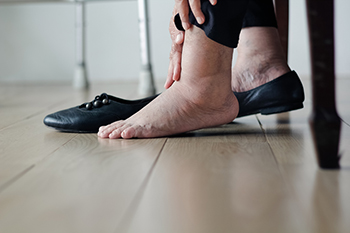
People who have swollen feet and ankles are generally aware of how uncomfortable they can be. There are various reasons why this can occur, including eating foods that have high levels of sodium, and taking certain medications. Additionally, pregnant women and people who are overweight may notice their feet are swollen, or it may happen as an allergic reaction from an insect bite. Mild relief can be found when salt intake is reduced in the diet, starting a gentle exercise routine, and frequently elevating the feet. It is beneficial to refrain from sitting or standing for long periods of time, in addition to wearing socks and shoes that are too tight. It can help to wear shoes that fit properly, and have a low heel and soft sole. Shiny skin on the feet can be a sign of edema, which is the medical term for swollen feet. Some people may experience a skin color change on their feet, and this may be a symptom of edema. If you have this condition, and you fail to find relief with the above suggestions, please consult with a podiatrist who can provide an examination and conclude with a proper diagnosis and treatment.
Swollen feet can be a sign of an underlying condition. If you have any concerns, contact Jack A. Sasiene, DPM of Texas. Our doctor can provide the care you need to keep you pain-free and on your feet.
Swollen feet are a common ailment among pregnant women and people who stand or sit for extended periods. Aging may increase the possibility of swollen feet and patients who are obese often notice when their feet are swelling too. There may be medical reasons why swollen feet occur:
- Phlebitis - A condition that causes the veins to become inflamed and can also cause leg pain.
- Liver disease - This may lead to low blood levels of albumin which is a protein. This can cause fluid in the blood to pass into the tissues and several areas of the body can become swollen.
- Heart failure - When the heart doesn’t pump properly the blood that is normally pumped back to the heart can pool in the veins of the legs causing swollen feet.
- Kidney disease - One of the main functions of the kidneys is releasing excess fluid in the body. This type of condition can make it difficult for the kidneys to function properly, and as a result the feet may become swollen.
- Deep-vein thrombosis (DVT)- This is a serious condition where blood clots form in the veins of the legs. They can block the return of blood from the legs to the heart which may cause the feet to swell. It is important to be treated by a podiatrist if this condition is present.
Swollen feet can also be caused by bone and tendon conditions, including fractures, arthritis, and tendinitis. Additionally, there may be skin and toenail conditions and an infection may cause the feet to swell. Patients who take medicine to treat high blood pressure may be prone to getting swollen feet.
Many patients elevate their feet to help relieve the swelling and this is generally a temporary remedy. When a podiatrist is consulted the reason behind the swelling can be uncovered and subsequently treated.
If you have any questions please contact our office located in Lake Jackson, TX . We offer the newest diagnostic and treatment technologies for all your foot and ankle needs.
The Many Differences Between Walkers and Runners
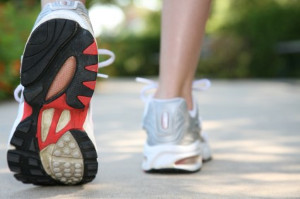
Running and walking are two different things and the shoes that are worn for each can vary in many ways. Walking shoes are generally stiffer than running shoes and many people who run, or jog enjoy wearing a shoe that is more flexible. It is beneficial to determine what the style of running is, and this consists of being a toe, midfoot, or heel striker. Running shoes are known for their stability and their ability to help correct overpronation. Comfort is the main reason why people will purchase walking shoes as too much cushioning in the shoe may possibly cause the legs to become stiff. A shoe that is flexible, lightweight, and flat is the type of shoe that fitness walkers prefer, and it is important to ensure the foot does not slide as each step is taken. Runners prefer additional cushioning in the heel and forefoot as this can make striking the ground with force more comfortable. If you would like more information about the many different types of running and walking shoes, in addition to the differences between them, please confer with a podiatrist.
For more information about walking shoes versus running shoes, consult with Jack A. Sasiene, DPM from Texas. Our doctor can measure your feet to determine what your needs are and help you find an appropriate pair of footwear.
Foot Health: The Differences between Walking & Running Shoes
There are great ways to stay in shape: running and walking are two great exercises to a healthy lifestyle. It is important to know that running shoes and walking shoes are not interchangeable. There is a key difference on how the feet hit the ground when someone is running or walking. This is why one should be aware that a shoe is designed differently for each activity.
You may be asking yourself what the real differences are between walking and running shoes and the answers may shock you.
Differences
Walking doesn’t involve as much stress or impact on the feet as running does. However, this doesn’t mean that you should be any less prepared. When you’re walking, you land on your heels and have your foot roll forward. This rolling motion requires additional support to the feet.
Flexibility – Walking shoes are designed to have soft, flexible soles. This allows the walker to push off easily with each step.
If you have any questions, please feel free to contact our office located in Lake Jackson, TX . We offer the newest diagnostic and treatment technologies for all your foot care needs.
More...
How Flat Feet Affects Runners
 Flat feet are a condition where the patient exhibits little or no arch in their feet. In other words, every part of the bottom of the foot, also known as the sole, rests entirely against the floor when standing on both feet. An individual can develop flat feet naturally as a matter of genetics, or in response to injury, aging, or pregnancy. Whatever the cause, flat feet can be a headache for runners. If you are running with flat feet, you might experience pain in the feet or knees. This may be caused by overpronation whereby some patients with flat feet excessively roll their feet inward to absorb shocks when walking or running. This possible overpronation can cause muscles in the feet to tighten. Also, flat feet might cause problems when running because the condition increases a runner’s susceptibility to suffering an injury or developing tendinitis. Tendinitis can affect the tendons around the heels and knees, essentially inflaming the tendon, which can lead to pain and tenderness. If you are a runner with flat feet, consider reaching out to a podiatrist who can help you address the problem. A podiatrist may recommend running with orthotics or shoe inserts to correct any possible overpronation.
Flat feet are a condition where the patient exhibits little or no arch in their feet. In other words, every part of the bottom of the foot, also known as the sole, rests entirely against the floor when standing on both feet. An individual can develop flat feet naturally as a matter of genetics, or in response to injury, aging, or pregnancy. Whatever the cause, flat feet can be a headache for runners. If you are running with flat feet, you might experience pain in the feet or knees. This may be caused by overpronation whereby some patients with flat feet excessively roll their feet inward to absorb shocks when walking or running. This possible overpronation can cause muscles in the feet to tighten. Also, flat feet might cause problems when running because the condition increases a runner’s susceptibility to suffering an injury or developing tendinitis. Tendinitis can affect the tendons around the heels and knees, essentially inflaming the tendon, which can lead to pain and tenderness. If you are a runner with flat feet, consider reaching out to a podiatrist who can help you address the problem. A podiatrist may recommend running with orthotics or shoe inserts to correct any possible overpronation.
Flatfoot is a condition many people suffer from. If you have flat feet, contact Jack A. Sasiene, DPM from Texas. Our doctor will treat your foot and ankle needs.
What Are Flat Feet?
Flatfoot is a condition in which the arch of the foot is depressed and the sole of the foot is almost completely in contact with the ground. About 20-30% of the population generally has flat feet because their arches never formed during growth.
Conditions & Problems:
Having flat feet makes it difficult to run or walk because of the stress placed on the ankles.
Alignment – The general alignment of your legs can be disrupted, because the ankles move inward which can cause major discomfort.
Knees – If you have complications with your knees, flat feet can be a contributor to arthritis in that area.
Symptoms
- Pain around the heel or arch area
- Trouble standing on the tip toe
- Swelling around the inside of the ankle
- Flat look to one or both feet
- Having your shoes feel uneven when worn
Treatment
If you are experiencing pain and stress on the foot you may weaken the posterior tibial tendon, which runs around the inside of the ankle.
If you have any questions, please feel free to contact our office located in Lake Jackson, TX . We offer the newest diagnostic and treatment technologies for all your foot care needs.
Why Live with Pain and Numbness in Your Feet?
Causes of Pain in the Second Toe
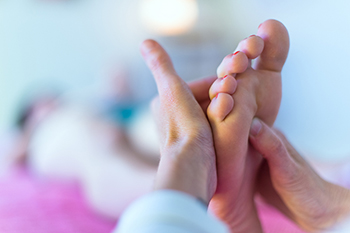
Pain in the second toe can cause a great deal of discomfort, but it is rarely discussed. One of the main causes of second toe pain is capsulitis, which is irritation or inflammation of the ligament capsule at the base of the toe. You may notice pain in the ball of the foot that feels worse when you walk barefoot, swelling in the area, and difficulty putting on or wearing shoes. Causes of capsulitis include improper foot mechanics, bunions, tight calf muscles, a weak arch, or a second toe that is longer than the big toe, which can affect the gait. Sometimes, if a person has capsulitis of the second toe, which causes it to drift toward the big toe, surgery may be required. If the pain associated with the second toe becomes debilitating or interferes with daily activities, it is wise to seek the help of a podiatrist who can diagnose the cause and provide treatment options.
Toe pain can disrupt your daily activities. If you have any concerns, contact Jack A. Sasiene, DPM of Texas. Our doctor can provide the care you need to keep you pain-free and on your feet.
What Causes Toe Pain?
Most severe toe pain is caused due to a sports injury, trauma from dropping something heavy on the toe, or bumping into something rigid. Other problems can develop over time for various reasons.
Toe pain can be caused by one or more ailments. The most common include:
- Trauma
- Sports injury
- Wearing shoes that are too tight
- Arthritis
- Gout
- Corns and calluses
- Hammertoe
- Bunions
- Blisters
- Ingrown toenails
- Sprains
- Fractures (broken bones)
- Dislocations
When to See a Podiatrist
- Severe pain
- Persistent pain that lasts more than a week
- Signs of infection
- Continued swelling
- Pain that prevents walking
Diagnosis
In many cases the cause of toe pain is obvious, but in others, a podiatrist may want to use more advanced methods to determine the problem. These can range from simple visual inspections and sensation tests to X-rays and MRI scans. Prior medical history, family medical history, and any recent physical traumatic events will all be taken into consideration for a proper diagnosis.
Treatment
Treatments for toe pain and injuries vary and may include shoe inserts, padding, taping, medicines, injections, and in some cases, surgery. If you believe that you have broken a toe, please see a podiatrist as soon as possible.
If you have any questions please contact our office located in Lake Jackson, TX . We offer the newest diagnostic and treatment technologies for all your foot and ankle needs.
The Burning Foot Syndrome
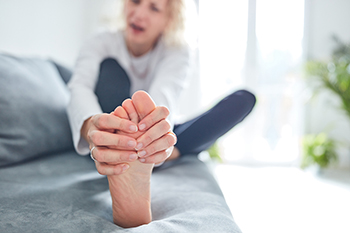
The rare foot condition that is known as Grierson-Gopalan syndrome is also referred to as burning feet syndrome. The symptoms of this ailment include a painful burning sensation on the bottom of the feet that may spread to the lower legs and top of the feet. There are several reasons why this condition may occur, including peripheral neuropathy, which can be common among diabetic patients. This is caused by nerve damage in the feet and may be a reason why burning feet syndrome arises. Morton’s neuroma is generally caused by wearing shoes that are too tight, causing a nerve between the toes to thicken. Additionally, some people undergo complex regional pain syndrome, which may happen after an injury has occurred or if surgery has been performed. It is a rare syndrome, and the burning pain may come from a nerve disorder. Immediate relief may be found when soaking the feet in cold water and elevating the feet to slow down the blood flow. If you have any symptoms of this disorder, it is strongly suggested that you confer with a podiatrist who can prescribe the necessary medications for you.
Some foot conditions may require additional professional care. If you have any concerns, contact Jack A. Sasiene, DPM of Texas. Our doctor can provide the care you need to keep you pain-free and on your feet.
Rare Foot Conditions
The majority of foot conditions are common and can be treated by a podiatrist. Standard diagnostic procedures are generally used to identify specific conditions and treatment can be rendered. A podiatrist also treats rare foot conditions which can be difficult to diagnose and may need extra attention and care.
There are many rare foot conditions that can affect children. Some of these can include:
- Freiberg’s disease
- Kohler’s disease
- Maffucci syndrome
Freiberg’s disease - This can be seen as a deterioration and flattening of a metatarsal bone that exists in the ball of the foot. It typically affects pre-teen and teenage girls, but can affect anyone at any age. Symptoms that can accompany this can be swelling, stiffness, and the patient may limp.
Kohler’s disease - This often targets the bone in the arch of the foot and affects younger boys. It can lead to an interruption of the blood supply which ultimately can lead to bone deterioration. The patient may limp or experience tenderness, swelling, and redness.
Maffucci syndrome - This affects the long bones in a child’s foot leading to the development of abnormal bone lesions. They are benign growths and typically develop in early childhood and the bones may be susceptible to breaking.
A podiatrist can properly diagnose and treat all types of rare foot conditions. If your child is affected by any of these symptoms or conditions, please don’t hesitate to call our office so the correct treatment method can begin.
If you have any questions, please feel free to contact our office located in Lake Jackson, TX . We offer the newest diagnostic and treatment technologies for all your foot care needs.



